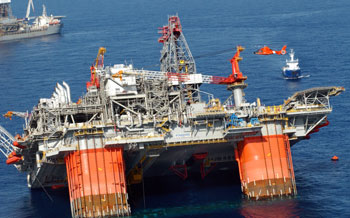 Like gold, the human connection with oil goes back centuries. Initially used for heating and light, oil has now become the lifeblood of industrialized nations.
Like gold, the human connection with oil goes back centuries. Initially used for heating and light, oil has now become the lifeblood of industrialized nations.
The Swedish bank Carnergie recently put together some quick facts about oil that are worth sharing.
World’s First Oil Production: Way back in the year 327, Chinese engineers used bamboo pipelines to drill 240 meters below the surface to extract the earliest drops of oil. Carnegie notes that back then, oil was known as “burning water” and was used to evaporate brine and produce salt.
World’s First Offshore Production: The first offshore production wasn’t that far offshore at all. In 1891, workers from Riley and Banker’s Oil drilled for oil in the Grand Lake St. Mary’s from a wooden platform. The lake is about 70 miles west of Columbus, Ohio.
World’s Deepest Offshore Well: The answer to this one we know all too well. Back in September 2009, Transocean’s Deepwater Horizon hit a depth of 10,683 meters, making it the deepest well in the world. The record was short-lived as the Deepwater Horizion blew up just over six months later.
World’s Longest Producing Oil Well: I wonder if the oil riggers in Titusville, Pennsylvania knew their handiwork would still be in use 150 years later? The McClintock #1 started producing back in August 1861 and is still producing today. The well once produced as much as 50 barrels per day but currently produces about 12 barrels a month.

McClintock #1 at Titusville, Pennsylvania
World’s Largest Offshore Oilfield: Measuring 50 kilometers by 15 kilometers, the Safaniya field in Saudi Arabia is the world’s largest offshore oilfield. Discovered in 1951, Safaniya is estimated to hold 37 billion barrels of oil and 151 billion cubic kilometers of gas. That’s enough oil to fulfill U.S. demand for nearly five years.
World’s Largest Offshore Gasfield: Measuring 9,700 square meters, the South Pars/North Dome in the Persian Gulf is the world’s largest offshore gasfield. Straddling the territories of Iran and Qatar nearly 3,000 meters below the seabed, the field holds 51 trillion cubic meters of gas.
Biggest Blowout in History: The blowout and aftermath of the Macondo well, which the Deepwater Horizon (see above) was drilling, is estimated to have spilled 4.9 million barrels of oil into the Gulf of Mexico.
World’s Largest Oil Platform: Weighing in at an amazing 59,500 tons, the largest oil platform in the world, the Thunder Horse PDQ, was built as a joint-venture between BP and ExxonMobil. Despite its size, this picture shows the platform is still susceptible to the elements, in this case 2005’s Hurricane Dennis.

Thunder Horse platform damaged after Hurricane Dennis
World’s Largest Floating Production Storage and Offloading (FPSO): ExxonMobil’s Kizomba A has a storage capacity of 2.2 million barrels of oil making it the largest in the world. The $800 million structure is currently in use off of the coast of Angola.

The FPSO receives and stores the oil after it is pumped from below the ocean floor
World’s Smallest FPSO: Sitting off the coast of southeast Australia is Roc Oil’s FPSO, which has the ability to hold 10,000 barrels per day of oil.
Visit Carnegie’s website for more info.
By clicking the link above, you will be directed to a third-party website. U.S. Global Investors does not endorse all information supplied by this website and is not responsible for its content. None of U.S. Global Investors family of funds held any of the securities mentioned in this article as of September 30, 2010. All opinions expressed and data provided are subject to change without notice. Some of these opinions may not be appropriate to every investor.
- Bulenox: Get 45% to 91% OFF ... Use Discount Code: UNO
- Risk Our Money Not Yours | Get 50% to 90% OFF ... Use Discount Code: MMBVBKSM
Disclaimer: This page contains affiliate links. If you choose to make a purchase after clicking a link, we may receive a commission at no additional cost to you. Thank you for your support!


Leave a Reply